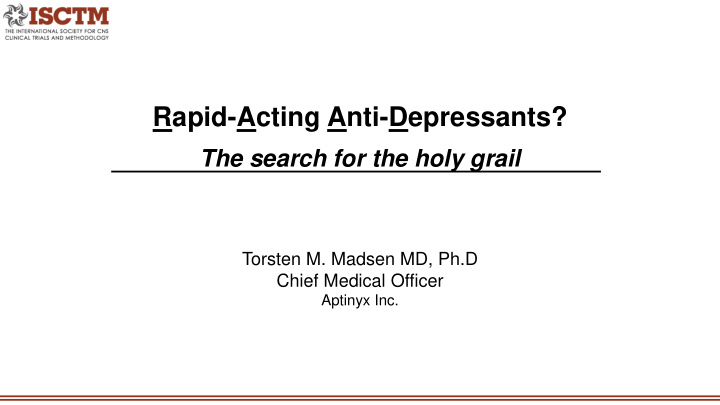



Rapid-Acting Anti-Depressants? The search for the holy grail Torsten M. Madsen MD, Ph.D Chief Medical Officer Aptinyx Inc.
RAAD seminar • Disclosures: • Full time employee at Aptinyx • (previous employee at Naurex, Lundbeck) • Holds stock in Aptinyx, Axial Biotheratherapeutics
Why Research Rapid Acting Antidepressive Effects? • Field in need of new therapeutic modalities • faster relief of symptoms is a major unmet need • Enhancement of therapeutic strategy and options • Differential - state-dependent - treatment • Fast understanding of value of treatment • Personalized medicine? • Health care provider information • No cure, no pay
RAAD. What is in a name? Tried the “millennial” approach: Googling • Roll Attitude Anomaly Detection • Iranian Air defense system • RAAD Festival ….Nothing on depression
RAADs Lecture(translated), May 19, 1958
Rapid Acting Antidepressive Effect • A Holy Grail of Psychiatry Pharmaceutical Research for Decades.
RAAD Research Several search parties over the past decades…… Different strategies pursued Monty Python and the Holy Grail
METHODOLOGIC REQUIREMENTS T TO AC ACHI HIEVE D DEFINITIVE RESULTS (K (Katz tz e et a t al, 1996) “In order to distinguish between early nonspecific effects of treatment and the effects of the active drug, a placebo control group is essential. Appropriately aggressive dosage schedules are required (Prien et al.,1985) as well as a study sample that is “assay-sensitive,”i.e., comprised of those depressed patients where a low placebo response rate is expected (Montgomery, 1995a). The detection of early onset can be further enhanced by developing separate criteria for “early improvement” and for full response or recovery. Because of the high dropout rate for placebo treated patients, it is useful to apply survival analysis. Studies will require methods for clear separation of treatment responders and nonresponders and for measuring change in the multiple behavioral components of depression. Studies that fully integrate this kind of conceptual and methodological information have yet to be carried out”. Katz et al, 1996
Rapid Acting Antidepressive Effect • Are we closer to a solution – and new treatment options? • Problems still looking for answers • Are the studies the rights design? • (Functional Un)blinding • Assessment instruments • The construct of MDD
Rapid Action. What are we looking for? • Sleep Deprivation (Adjunct triple chronotherapy). Open label study, 10 patients From: Sahlem et al. J Psychiatr Res. 2014J Psychiatr Res. 2014 Dec; 59: 101–107..
Effects o s of “Triple C Chronotherap apy” o on De Depressi ssion S Symptoms s CSSRS HAM-D6 From: Sahlem et al. J Psychiatr Res. 2014J Psychiatr Res. 2014 Dec; 59: 101–107..
Is ECT Rapid Acting? Cumulative Response after ECT 100 90 80 70 60 50 40 30 20 10 0 1 2 3 4 5 6 7 8 9 10 11 first response sustained repsonse remission From:Husain et al, J. Clin Psych 2004
Blin indin ing of of e experim riments. . Ketamin ine example le From: Wilkinson et al 2019
Blin indin ing of of e experim riments. . Es Esketamin ine Esketamine (black) Placebo (grey) From: FDA Esketamine PDAC, study 3002
Functional unblinding with rapid acting therapies Dissociation and relationship to efficacy “Dissociative side effects… correlated with change in depression on the day of infusion and seven days post-infusion… The present correlation suggests dissociative side effects as a clinical biomarker to predict ketamine’s efficacy.”
Functional unblinding • Which studies to require for demonstration of efficacy? • Placebo-control? • Randomized withdrawal? For RAAD? • No studies available to assess efficacy of novel RAADs vs other currently approved and used treatments • How to understand the effect size in these studies? • Vs a surrogate placebo? • Vs a suboptimal blind?
Functional unblinding • The recent PDAC seemed to acknowledge a randomized withdrawal design as supportive for efficacy for a drug which claims rapid action as an important attribute. • An other ongoing program in the RAAD field (Rapastinel) will also– according to clinicaltrials.gov – report data from short-term, placebo-controlled and randomized withdrawal design studies
Assessment Instruments I: • Montgomery Asberg Depression Rating Scale: • Developed in 1979, based on data from 54 English and 52 Swedish Depressed Individuals • 64 contributed data for the analysis • Outpatients and inpatients • 10 Items (out of 65 on the CPRS) selected for MADRS
Assessment Instruments II: • Montgomery Asberg Depression Rating Scale: • MADRS Items picked based on sensitivity to change (to Maprotiline, clomimipramine, amitriptyline, mianserine) • Is this instrument still valid and relevant to detect change with compounds with novel MoAs, in a 2019 population of patients diagnosed with MDD, per current guidelines • If not, what instrument is?
In closing: • Several challenges associated with assessing RAADs…. • Thank you to all my colleagues who have taken this challenge!
Recommend
More recommend